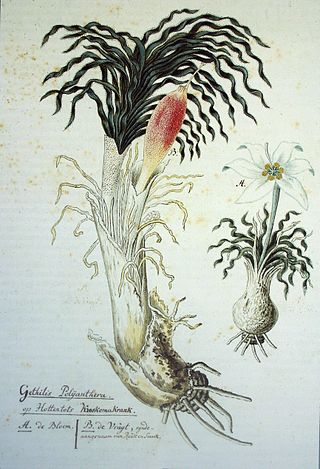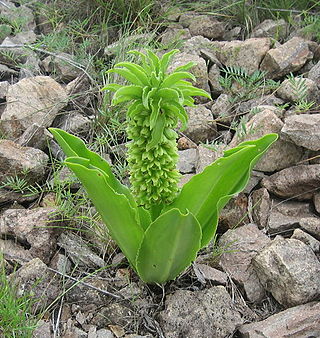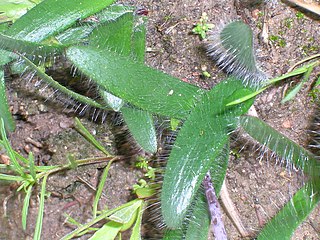
Amaryllis is the only genus in the subtribe Amaryllidinae. It is a small genus of flowering bulbs, with two species. The better known of the two, Amaryllis belladonna, is a native of the Western Cape region of South Africa, particularly the rocky southwest area between the Olifants River Valley and Knysna.

Sparaxis is a genus of flowering plants called the harlequin flowers. It belongs to the iris family Iridaceae with about 13 species endemic to Cape Province, South Africa.

Freesia is a genus of herbaceous perennial flowering plants in the family Iridaceae, first described as a genus in 1866 by Christian Friedrich Ecklon (1886) and named after the German botanist and medical practitioner, Friedrich Freese (1795–1876). It is native to the eastern side of southern Africa, from Kenya south to South Africa, most species being found in Cape Provinces. Species of the former genus Anomatheca are now included in Freesia. The plants commonly known as "freesias", with fragrant funnel-shaped flowers, are cultivated hybrids of a number of Freesia species. Some other species are also grown as ornamental plants.

Kniphofia is a genus of perennial flowering plants in the family Asphodelaceae, first described as a genus in 1794. All species of Kniphofia are native to Africa. Common names include tritoma, red hot poker, torch lily and poker plant.

Nerine is a genus of flowering plants belonging to the family Amaryllidaceae, subfamily Amaryllidoideae. They are bulbous perennials, some evergreen, associated with rocky and arid habitats. They bear spherical umbels of lily-like flowers in shades from white through pink to crimson. In the case of deciduous species, the flowers may appear on naked stems before the leaves develop. Native to South Africa, there are about 20–30 species in the genus. Though described as lilies, they are not significantly related to the true lilies (Liliaceae), but more closely resemble their relatives, Amaryllis and Lycoris. The genus was established by the Revd. William Herbert in 1820.

Pleiospilos is a genus of succulent flowering plants of the family Aizoaceae. It is endemic to the Cape Provinces of South Africa. The name is derived from the Greek pleios "many" and spìlos "spot". The plants are also known as kwaggavy, lewerplant, lewervygie, klipplant, split rock or mimicry plant.

Gethyllis, commonly called Kukumakranka, Koekemakranka, or Kroekemakrank, is a genus of bulbous plant in the amaryllid family with some 33 accepted species. It is native to the Cape Provinces, the Northern Provinces and the Free State of South Africa, as well as Botswana and Namibia.

Strumaria is a genus of African plants in Amaryllis family, subfamily Amaryllidoideae. The genus is known in nature only from South Africa, Lesotho and Namibia. Almost all species flower in the autumn and are cultivated as ornamental bulbous plants.

Eucomis autumnalis, the autumn pineapple flower, or autumn pineapple lily, is a species of flowering plant in the family Asparagaceae, subfamily Scilloideae, native to Malawi, Zimbabwe and southern Africa. It is a mid to late summer flowering deciduous bulbous perennial. The flower stem reaches about 40 cm (16 in), rising from a basal rosette of wavy-edged leaves. The green, yellow or white flowers are arranged in a spike (raceme), topped by a "head" of green leaflike bracts. It is grown as an ornamental garden plant and can also be used as a cut flower.

AnacampserosL. is a genus comprising about a hundred species of small perennial succulent plants native to Southern Africa, Ethiopia and Latin America. The botanical name Anacampseros is an ancient one for herbs supposed to restore lost love.

Hessea is a genus of bulb-forming plants in the Amaryllis family native to Namibia and South Africa. The genus name commemorates C. H. F. Hesse (1772–1832), who resided in Cape Town from 1800 to 1817.

Dierdré "Dee" Anne Snijman is a South African botanist and plant taxonomist who is notable for studying and writing extensively on bulbs. She has described over 120 species and has written comprehensive works on South African flora. She received the 1997 Herbert Medal from the International Bulb Society for her research on Amaryllis.

Strumaria chaplinii is a species of bulbous flowering plant in the family Amaryllidaceae, native to south-west Cape Provinces. It was first described in 1944 as Hessea chaplinii.

Strumaria gemmata is a species of flowering plant in the family Amaryllidaceae, native to the Cape Provinces and the Free State of South Africa. It was first described by John Bellenden Ker Gawler in 1814.
Strumaria massoniella is a species of flowering plant in the family Amaryllidaceae, native to the Cape Provinces of South Africa. It was first described in 1985 as Gemmaria massoniella. Its bulb is solitary. Like other members of the genus Strumaria it has star-shaped flowers. In the Northern Cape Province, it is found in sandy plains at an elevation of about 1,000 m (3,300 ft).

Strumaria tenella is a species of flowering plant in the family Amaryllidaceae, native to Lesotho, and the Cape Provinces and Free State of South Africa. It was first described by Carl Linnaeus the Younger in 1782 as Crinum tenellum. Its inflorescence of white flowers has been described as "noticeably starry".

Strumaria truncata is a species of flowering plant in the family Amaryllidaceae, native to the Cape Provinces of South Africa. It is widely distributed in the northwest of the Cape Provinces, and the most common of the Strumaria species found there. It forms small clumps of bulbs which produce twisted leaves. Its flowers, which are sometimes pendulous, vary in colour from white to deep pink. The pink forms were once treated as a separate species, Strumaria rubella, and have also been called var. rubella. The species was first described by Nikolaus Joseph von Jacquin in 1792.

Strumaria watermeyeri is a species of flowering plant in the family Amaryllidaceae, native to the Cape Provinces of South Africa, where it is found in dry areas in the northwest. It is usually solitary, and has pink or white flowers. It was first described by Louisa Bolus in 1921.
















